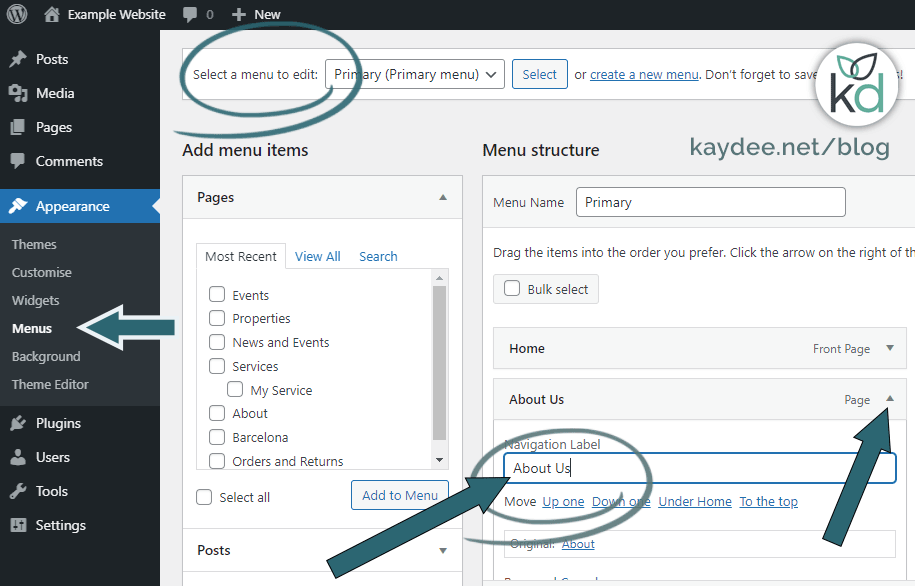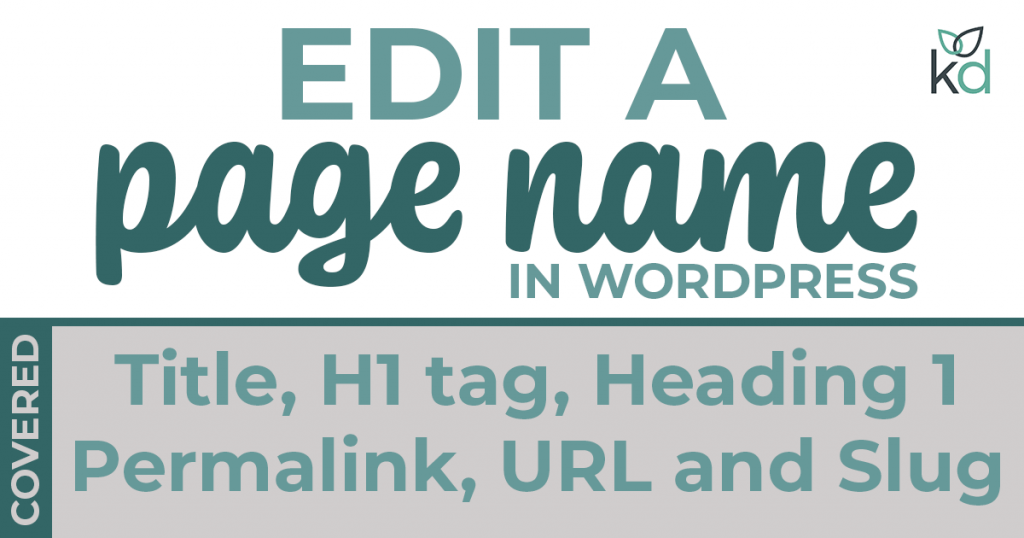To edit a page name in WordPress, you’ll need the Administrator WordPress username and password. Inferior roles have fewer capabilities and cannot rename pages, posts, or menus.
Once logged into the WordPress backend, you’ll be able to edit:
- Post or page titles – heading 1 or an h1 tag.
- The slug – the page name. It is visible at the end of the permalink or WordPress URL, shown in the browser address bar.
- The navigation label – the menu label or menu button.
The three labels coincide when you create a WordPress page or post. They are the same.
Perhaps you’ve not realised that the page title, slug, and navigation label can be edited separately; they can all be completely different.
The three should correspond for good search engine optimisation, but often, website designers want to use a sort navigation label, for example. This is entirely possible.
Read on; I’ll explain.
Navigate this page:
- The WordPress page title and the navigation label
- Edit the navigation label
- Edit a page title in WordPress
- What’s the difference? URL, permalink or slug?
- Creating a title and a slug
- Pretty permalinks for WordPress
- Cautions to take when you edit the slug in WordPress
- How to edit a permalink in WordPress
The WordPress page title and the navigation label
Changing a WordPress page title (heading 1) is a simple task.
Editing a page title won’t change the slug; it stays the same until you manually edit it.
However, the navigation label (the menu text) will change to correspond with the page title. The menu reflects page titles.
You can separate the two by changing the navigation label manually.
Go through these instructions before you make changes to a live website; learn to change the navigation label before you edit a WordPress page title.
Edit the navigation label

- From the left-hand menu, go to APPEARANCE > MENUS.
- You’ll need to be on the ‘Edit Menus’ tab.
- Select the menu you want to edit.
- Hit the arrow icon associated with the menu item to be changed.
- Find the field NAVIGATION LABEL. The text you enter here will show on the navigation bar despite the page title.
- Save the menu.
Change the navigation label BEFORE you edit the page title. That way, the navigation label sticks, overriding the page title.
When you go back to edit the WordPress page title, you can now do so confidently. The page title will no longer overwrite the navigation label.
Does that make sense?
Edit a page title in WordPress
A super-fast way to edit the page title
- Go to Pages on the left-hand menu within WordPress.
- On the Pages screen, hover over any page and click Quick Edit.
- Normally, the title field contains the text used as the heading 1 (H1) tag. Change the page title here.
Edit the page title on the page
Easily edit the page title on the WordPress ‘edit page’ screen too.
- Click to select the title and start typing.
- Now, hit the blue Update button to save the page.

A side note – a WordPress page editor will look entirely different from the image above. Find out which page editor you’re using and search Google to edit the page title within that page editor.
What’s the difference? URL, permalink or slug?
A URL is the entire domain name, parent category, and page name. You’ll see the URL in a browser address bar; they change as you move through a website.
The URL for this post is https://kaydee.net/blog/edit-page-name-wordpress/
URL is the official name and stands for universal resource locator.
WordPress’ name for the URL is permalink.
A WordPress slug is a name for an individual post, page, category, or tag. It should be ‘friendly’ or easy to read for humans (see pretty permalinks below).
The slug for this page is ‘edit-page-name-wordpress‘.
Creating a title and a slug
When you create a WordPress page or post, the original title of the page becomes the slug. However, you can edit the slug.
A title such as ‘Our Services’ will create the slug ‘our-services’.
File names are always joined words with dashes between them. Across the web, a dash represents a space.
Pretty permalinks for WordPress
You can change the slug; it’s not set in stone. One reason to edit the slug is to optimise the page for search engines.
Why change the page slug?
A pretty URL (or pretty permalink) is one that humans understand. When a URL makes sense, page rank can be improved.
For good SEO, the slug, the page title and the content of the page must correspond.
A page title must be a complete sentence for humans to understand. But a slug should be short and tidy. Take out the small joining words in a slug for good SEO practice.
Google is advanced enough to understand the context of a sentence without joining words. Let’s look at that.
By ‘joining words’, I mean connectives (prepositions, conjunctions and adverbs). Words like “the, a, in, and, to, because, therefore”.
These words form sentences by joining nouns and verbs. They are also known as linking words, but I like to use ‘join’ – ‘link’ already means so much on the net.
Cautions to take when you edit the slug in WordPress
Be super careful when changing a slug, please. If you don’t know what you are doing, slug changes can end in dire results.
Editing WordPress permalinks can:
- Create dud links on the website or blog.
- Send search engine listings to the 404 error page.
- Cause backlinks to no longer work.
These factors are negative signals to search engines. Fix them quickly, or the website will rapidly lose rank.
Follow these steps very carefully and install a redirect plugin, which I go over at the end of this post.
Once you’ve changed a permalink, go to the front end to check everything works. Check the navigation and all links to pages.
These days, WordPress links to page ID rather than page name, so links should still be correct in theory. However, a rule in web design is always to check.
Older versions or manual menu links will break, so I want you to proceed cautiously.
WordPress menu not working?
If the menu isn’t working, go to Appearance > Menus, where you’ll need to re-add pages.
Manually entered URLs will need changing within the HTML code.
How to edit a permalink in WordPress
Pretty URLs will help pages and posts rank better on search engines. Please read the above warnings before editing permalinks.
In WordPress, here’s how to change the URL:
Start by going to PAGES via the main menu on the left-hand side of WordPress.
Edit the WordPress URL (the quick way)
- On the All Pages or All Posts lists, permalinks are edited using QUICK EDIT.
- Hover over the page title and click Quick Edit.
- You’ll see the field for the permalink is labelled ‘Slug’ within the quick editor.
Edit the WordPress URL via the post/page edit option
- From the All Pages area, click the page title to edit it.
- You’ll probably need to unhide the page/block settings—they’re hidden by default. To do so, just hit the cog icon at the top right of the page.
- A sidebar appears on the right-hand side, where you’ll see:
- the post/page settings and
- settings for any block that is selected.
- You’ll need the settings for the page or the post. The tab will be named one or the other – click that.
- Scroll down this area on the right-hand side of the page to find the word Permalink. Click the word Permalink to toggle the settings.
- Now, change the words in the field labelled ‘URL slug’. WordPress will replace any spaces with dashes (-).
- Click the blue UPDATE button to save the changes.

Redirection plugins for WordPress
There’s a straightforward and excellent redirection plugin for WordPress.org called Redirection by John Godley. Thank you, John!
Add the redirection plugin before you change any slugs.
Within the options (TOOLS > REDIRECTION > OPTIONS), you can monitor posts, pages, and other post types for changes. You can also set up automatic redirects when slugs change. The old URL will redirect to the new URL.
Redirect loops
When people change the URL more than once due to indecision, they end up with a redirect loop.
The first URL redirects to the second, the second to the third, the third to the fourth. Redirects are a negative signal to search engines because they impair the ability to serve the final page.
If you’ve got yourself into a redirect loop using Redirection by John Godley, it’s fixable.
On WordPress’ main menu, on the left-hand side, go to TOOLS > REDIRECTION. You’ll need to be in the Redirects area to see all the redirects currently working on the site.
You want the original URL to go to the final URL in a purist world.
If you have an interim page that has started to rank on the search engines, you may want to redirect it to the final URL, too.
Delete any of the redirects created whilst minds were indecisive.
The conclusion to edit a page name in WordPress
Editing a page name in WordPress comes with responsibilities. There is a noticeable difference between a page title, the permalink and the navigation label, but all can be changed and should have slight differences.
If you change permalinks, back up the website first and proceed with caution. Always have someone on hand to restore the website if something goes awry.


Thanks for providing such valuable information.
Thanks
No worries Andy!